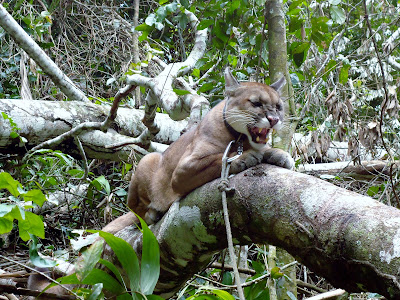 |
| Simba |
We just finished our month of volunteering at the Jacj Cuisi animal refuge in northern Bolivia. I arrived giddy to work with a puma, but unfortunately found it frustrating and scary. The park lies on the edge of the Amazon rainforest and is home to four pumas, all rescued from the black market or other abusive situations. Each puma lives in its own huge cage, reminiscent of Jurassic Park, and has its own set of trails surrounding it. Two volunteers work with each cat for at least a month, walking it for about 5 hours a day, 6 days a week. They use thick rope as a leash, attached to both the cat and the volunteer with carabineers.

I was assigned to Simba, who was sweet at first. When my partner and I approached his cage every morning, he would leap up purring, eager to lick our forearms in affection. Walking him was alternately exhausting and boring. We weren’t allowed to pull on the rope, but rather followed behind him, doing whatever he wanted to do. If he sat down to nap for two hours, we sat next to him for two hours. If he set off running down a steep trail, I ran shrieking behind him, dodging stumps and branches, terrified that I would trip and get dragged through the brush. If he refused to start his walk, we were supposed to tie him to a tree and wait until he finally gave up and reluctantly started down the trail. This could take over an hour, while I sat wondering why we couldn’t just leave him in his cage on days when he didn’t want to walk. I suppose the novelty of interacting with a puma wore off quickly for me and I felt like I was walking a spoiled, badly behaved dog.

 |
| Where we dined |
Then there was the jumping. When the pumas attack you, playfully pouncing onto your leg or pushing you down to the ground, they call it a “jump.” We were trained to stand our ground when this happens and calmly, firmly show the cat that we are not toys. Running or fighting would just excite them to chase us and bat us around like a mouse. Simba was usually fairly calm, but he gets agitated when he meets new people. After my first week with him, we introduced another new volunteer who would be my partner for the rest of the month. The moment I opened the cage Simba lurched out and wrapped his paws around my leg, latching onto my thigh with his giant teeth (I still have bruises from it). I did what I was supposed to – stayed calm, said “NO”, and stuck out my forearm for him to lick. It worked to get him off my leg but then he bit down on my wrist, pinching the skin between his teeth. Pulling my arm away just made him bite harder, and I felt powerless to stop him. My partner managed to distract him away from me, but after that I was a useless volunteer. When he jumped on my partner I screamed and leapt back instead of helping him, and I was constantly scared of being near Simba. I guess some volunteers build wonderful bonds with their cat, but I just felt like Simba was a wild animal who could easily kill me if he wanted to. I understand that he’s playing and not hunting when he jumps on us, but I’ve seen housecats “play” with mice and they usually end up in two pieces.
 |
| Where we bathed |
 |
| Tk's cat, Luna |
That afternoon I asked to stop working with Simba, so I finished my month doing less exciting but more comfortable work at the camp. Tk wasn’t frightened by his puma, Luna, but found the job boring and got annoyed with the royal treatment lavished on the cats. He stuck with it longer than I did, but also switched to camp work after a couple weeks. We started a garden, planted fruit trees, built a compost, cleared trails, and cooked many meals. About fifteen volunteers live there at any given time, from all over the world, plus one Bolivian family who runs the park, and a veterinarian. We took turns cooking communal meals, and Tk and I cooked more than the others since we didn’t work with the pumas.
 |
| Building a compost |
 |
| Super lindo three-stage compost |
 |
| Garden plot we planted |
It wasn’t what I had looked forward to, and we questioned the merit of this organization dedicating so much money ($10,000 a cage plus food and meds) and hours of volunteers’ time to ensuring the highest quality of life for four cats that can never reproduce or be reintroduced to the wild. Especially considering that the streets of Bolivia are overrun with stray dogs that no one gives a thought to. But I was impressed to see a Bolivian-run organization with a sincere commitment to preserving wildlife. We made the best of our time there, and I would even like to return in a few years when they have a monkey reintroduction facility. It was fun getting to know the other volunteers, from Canada, the U.S., Australia, France, Switzerland, Germany, Spain, Belgium, Lithuania, and Korea. (Everyone spoke English.) And of course, the jungle was beautiful.
 |
| Mad machete skills - clearing a second plot for tomatoes |
Now we’re super excited to spend three months in Panama, working with preschoolers and permaculture.











.jpg)
Love seeing those two smiling faces- oh, the cats are ok too!
ReplyDeleteI would be scared too if a puma jumped me, as cute as they are.
ReplyDelete